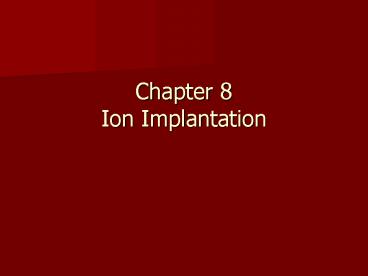Chapter 8 Ion Implantation - PowerPoint PPT Presentation
1 / 29
Title:
Chapter 8 Ion Implantation
Description:
Channeling Deep penetration by the ion because it traveled along a path where no semiconductor atoms are situated Process is ... due to thermal expansion ... – PowerPoint PPT presentation
Number of Views:210
Avg rating:3.0/5.0
Title: Chapter 8 Ion Implantation
1
Chapter 8Ion Implantation
2
ION IMPLANTATION SYSTEM
- Ion implanter is a high-voltage accelerator of
high-energy impurity ions - Major components are
- Ion source (gases such as AsH3 , PH3 , B2H6)
- Mass Spectrometer (selects the ion of interest)
- HV Accelerator (voltage gt 1 MeV)
- Scanning System (x-y deflection plates for
electronic control) - Target Chamber (vacuum)
3
ION IMPLANTATION SYSTEM
- Cross-section of an ion implanter
m/q(B2R2)/(2V)
Or Faraday cup
Acceleration energy voltage x charge on ion
4
http//www.bpc.edu/mathscience/chemistry/images/pe
riodic_table_of_elements.jpg
5
ION IMPLANTATION
- High energy ion enters crystal lattice and
collides with atoms and interacts with electrons - Types of collisions Nuclear and electron
- Each collision or interaction reduces energy of
ion until it comes to rest - Amount of energy loss is dependent on ion, the
energy it has at the time of the scattering
event, and the type of scattering.
6
From Handbook of Semiconductor Manufacturing
Technology by Yoshio Nishi and Robert Doering
7
From Handbook of Semiconductor Manufacturing
Technology by Yoshio Nishi and Robert Doering
8
Channeling
- Deep penetration by the ion because it traveled
along a path where no semiconductor atoms are
situated - Process is used for materials characterization
Rutherford backscattering - To prevent channeling
- Implantation is performed at an angle of about
8 off the normal to the wafer surface. - The wafer surface is amorphorized by a high dose,
low energy implantation of a nonelectrically
active ion. - Hydrogen, helium, and silicon are common ions
used
9
Determining the Dose
- The implanted dose can be accurately measured by
monitoring the ion beam current using a Faraday
cup - The integrated current during the implant divided
by the charge on the ion is the dose.
10
Post Implantation Anneals
- An annealing step is required to repair crystal
damage (recrystallization) and to electrically
activated the dopants. - Dislocations will form during the anneal so times
and temperatures must be chosen to force
dislocations disappear. - If the anneal time is long and the temperature is
high, a drive of the implanted ions may occur.
11
ION IMPLANTATION
- Projected range (RP) the average distance an ion
travels before it stops. - Projected straggle (?RP) deviation from the
projected range due to multiple collisions.
http//eserver.bell.ac.uk
12
MODEL FOR ION IMPLANTATION
- Distribution is Gaussian Cp peak
concentration - Rp range
- ?Rp straggle
13
MODEL FOR ION IMPLANTATION
- For an implant contained within silicon, the dose
is
14
ION IMPLANTATION MODEL
- Model developed by Lindhard, Scharff and Schiott
(LSS) - Range and straggle roughly proportional to energy
over wide range - Ranges in Si and SiO2 roughly the same
- Computer models now available
15
Range of impurities in Si
16
Straggle of impurities in Si
17
Si
SiO2
AZ-7500 resist
Si3N4
http//www.iue.tuwien.ac.at/phd/hoessinger/node22.
html
18
http//www.ensc.sfu.ca/glennc/e495/e495l7j.pdf
19
http//www.ensc.sfu.ca/glennc/e495/e495l7j.pdf
20
SiO2 AS A BARRIER
- The minimum oxide thickness for selective
implantation - Xox RP ?RP (2 ln(10CP/CBulk))0.5
- An oxide thickness equal to the projected range
plus six times the straggle should mask most ion
implants.
21
Other Materials
- A silicon nitride barrier layer needs only be 85
of the thickness of an oxide barrier layer. - A photoresist barrier must be 1.8 times the
thickness of an oxide layer under the same
implantation conditions. - Metals are of such a high density that even a
very thin layer will mask most implantations. - Nickel is one of the most commonly used metal
masks
22
ADVANTAGES
- Low temperature process
- The wafer is cooled from the backside during high
energy, high current diffusions are performed - Less change of stress-induced dislocations due to
thermal expansion issues - Wider range of barrier materials
- Photoresist
- Wider range of impurities
- No concern about solid solubility limitations
- Implantation of ions such as oxygen, hydrogen,
helium, and other ions with low solid solubility
is possible.
23
Advantages over Diffusion
- Better control and wider range of dose compared
to predep diffusions - Impurity concentration profile controlled by
accelerating voltage - Very shallow layers
- Lateral scattering effects are smaller than
lateral diffusion.
24
- Complex-doping profiles can be produced by
superimposing multiple implants having various
ion energies and doses.
25
RADIATION DAMAGE
- Impact of incident ions knocks atoms off lattice
sites - With sufficient dose, can make amorphous Si layer
26
RADIATION DAMAGE
- Critical dose to make layer amorphous varies with
temperature and impurity
27
Recrystallization
- Radiation damage can be removed by annealing at
800-1000oC for 30 min. After annealing, a
significant percentage of the impurities become
electronically active. - Point defects coalesce into line dislocations
- Line dislocations merge into loop dislocations
- Loop dislocations slowly disintegrate as
interstitial Si atoms move on to lattice sites
28
Ion Implantation
- Implanting through a sacrificial oxide layer
- Large ions (arsenic) can be slowed down a little
before penetrating into the silicon. - The crystal lattice damage is suppressed (at the
expense of the depth achieved). - Collisions with the thin masking layer tends to
cause the dopant ions to change direction
randomly, thereby suppressing channeling effect. - The concentration peak can be brought closer to
the silicon surface.
29
Ion Implantation
- For deep diffusion (gt1µm), implantation is used
to introduce a certain dose, and thermal
diffusion is used to drive in the dopants. - The resulting profile after diffusion can be
determined by































